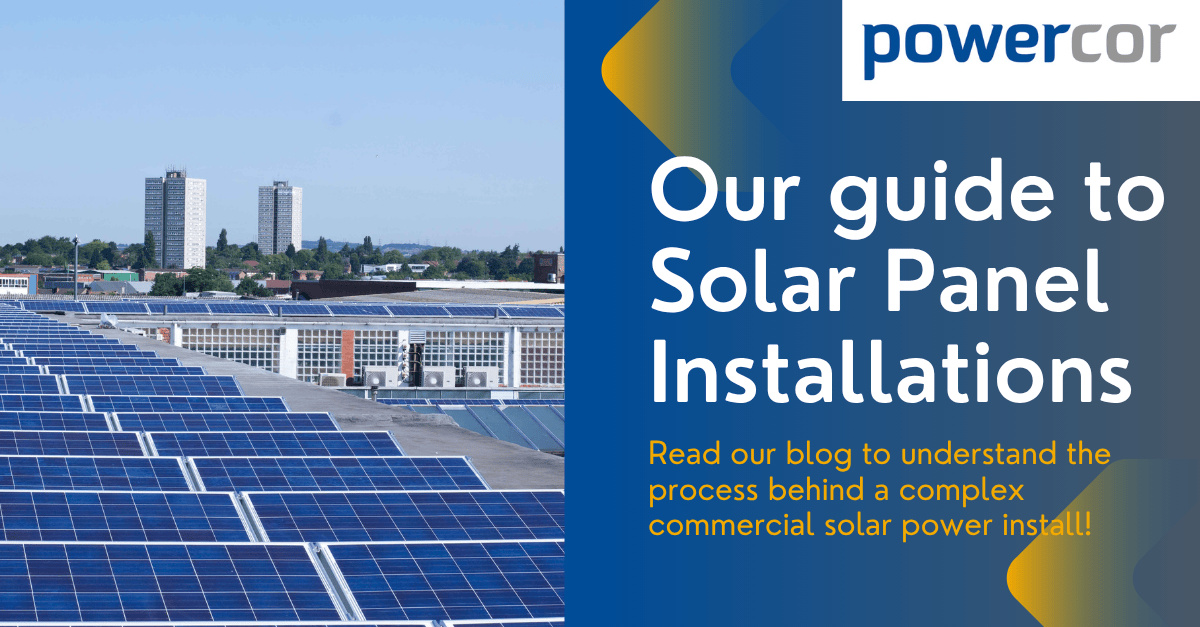With commercial solar installations in many ways being a strategic business investment, it can be useful for a business to work through a guide to solar panel installation when considering allocating funds in this way. Warehouses, office blocks, retail centres and industrial facilities across the UK are increasingly turning to solar to combat rising energy costs and meet carbon reduction goals.
A successful solar project requires a carefully structured approach that considers building suitability, regulatory requirements, technology selection and long-term performance.
Powercor has installed numerous medium and large-scale solar installations across a variety of schools and commercial buildings and below is our step-by-step guide to solar panel installation for property owners thinking about taking advantage of solar power:
Step 1: Assess your building and energy profile
Before committing to solar, conduct a thorough assessment of your building and current energy usage:
- Energy audit – examine historic electricity bills and half-hourly meter data to identify consumption patterns and peak demand periods. Alternatively install a metering and measurement system to do this for you.
- Roof structure – check the roof’s condition and load-bearing capacity. Commercial solar panels typically add 15–20 kg per m². A structural survey will confirm whether reinforcement is needed.
- Roof orientation and tilt – south-facing roofs capture the most sunlight, but east–west arrays can generate more consistent power throughout the day.
- Shading analysis – chimneys, plant equipment, and neighbouring buildings can create shadows that reduce output.
- Ground-mounted options: if roof space is limited, consider adjacent land for a ground-mounted array, subject to planning.
This step ensures the system is sized to meet your operational demand and makes the most of your available surface area.
Setp 2: Understand planning and grid requirements
Solar installations on commercial buildings in the UK generally fall under permitted development rights, but there are exceptions:
- Systems exceeding 1 MW or altering the building’s external appearance significantly may require planning permission.
- Properties in conservation areas or listed buildings often require special consent.
- Large-scale generation may require a G99 application to your Distribution Network Operator (DNO) to connect safely to the local grid.
Early engagement with the DNO avoids delays, especially if you plan to export surplus energy and benefit from schemes like the Smart Export Guarantee (SEG).
Setp 3: Select the right solar technology
Commercial solar performance depends heavily on technology choice:
- Monocrystalline panels – high efficiency, ideal for smaller roofs where space is at a premium.
- Polycrystalline panels – lower cost per panel, suitable for expansive roof areas.
- Bifacial panels – capture reflected light from the roof or ground, boosting yield in bright conditions.
- Smart inverters – essential for commercial arrays, these convert DC to AC efficiently and allow real-time monitoring, performance reporting, and predictive maintenance.
Many businesses now combine solar with optimisers to mitigate shading losses and remote monitoring to track every kilowatt generated and consumed.
Powercor partners with leading manufacturer, Solar Edge, to bring customers the latest solar technology benefits.
Setp 4: Integrate energy storage and smart building management
Solar panels generate electricity during daylight hours, which may not align perfectly with your consumption. To maximise your return on investment:
- Battery storage systems can store excess energy for evening use or peak demand periods.
- Load shifting strategies can move high-energy processes, like refrigeration or charging EV fleets, to periods of peak solar production.
- Building Management System (BMS) integration enables automated load control, prioritising solar usage over grid supply.
- Advanced metering and IoT devices provide granular data on energy flows, allowing facilities managers to optimise performance and quickly detect anomalies.
This combination transforms solar from a passive generator into an active tool for energy management.
Step 5: Plan installation with minimal disruption
Commercial solar projects can be completed with little interference to daily operations when well planned:
- Phased installation – modular racking and panel systems allow sections of the roof to be completed progressively.
- Weekend or off-peak work – reduces operational impact, especially for 24/7 facilities.
- Health and safety protocols – certified installers adhere to UK roofing and electrical safety standards to protect both staff and assets.
Step 6: Monitor, maintain and maximise performance
Post-installation, ongoing optimisation ensures the system delivers long-term returns:
- Performance monitoring detects underperforming strings or inverter issues early.
- Annual inspections check panel integrity, wiring, and mounting systems.
- Panel cleaning may be required in areas prone to dust or bird droppings.
- Firmware updates for inverters and monitoring systems keep performance at peak.
A well-maintained solar system can deliver 25–30 years of reliable service with minimal performance degradation.
Step 7: Capture financial and ESG benefits
Solar delivers more than just lower electricity bills:
- Carbon reduction and ESG reporting – demonstrate progress on net zero commitments.
- Improved property value – energy-efficient buildings attract tenants and investors.
- Marketing advantage – visible rooftop arrays can be a statement of sustainability.
- Export revenue – surplus power can be sold under the Smart Export Guarantee.
Forward-thinking companies are using solar to lock in predictable energy costs and meet corporate sustainability expectations.
Powercor has installed and optimised solar systems for a wide range of UK commercial properties. By using this guide to solar panel installation, businesses will have a clearer indication of what the solar install process involves when looking to unlock significant cost savings while reducing their carbon footprint through this clean energy source.
Q&As:
How long does a commercial solar installation usually take?
Most medium to large installations take between two and six weeks, depending on roof size, system complexity, and weather conditions. The process includes surveying, mounting, electrical connection, and testing before the system becomes fully operational. Early planning and grid approval can help avoid unnecessary delays.
Can a solar system power a building entirely off-grid?
Yes, but it requires a large battery storage system and backup generators to ensure energy is available during periods of low sunlight. Most commercial sites use a hybrid approach, combining on-site generation with a grid connection for reliability and cost-effectiveness.
How often do commercial solar panels need maintenance?
Routine annual inspections are usually sufficient to keep the system running efficiently, alongside cleaning in dusty or high bird activity areas. Modern monitoring systems can flag any performance drops, allowing maintenance teams to respond quickly. This proactive approach extends the system’s lifespan and maximises return on investment.
Will installing solar panels disrupt daily operations?
Professional installers plan projects to minimise disruption, often using phased work and scheduling around off-peak hours or weekends. With careful coordination, most businesses remain operational throughout the installation. For 24/7 sites, temporary safety barriers or limited access areas can ensure continuity of operations.
What factors affect the return on investment for solar panels?
ROI depends on energy consumption patterns, available roof space, system efficiency, and how much energy can be self-consumed or exported. Incorporating battery storage and smart energy management can significantly increase savings. Choosing a high-quality installation partner also ensures long-term performance and reduced maintenance costs.







